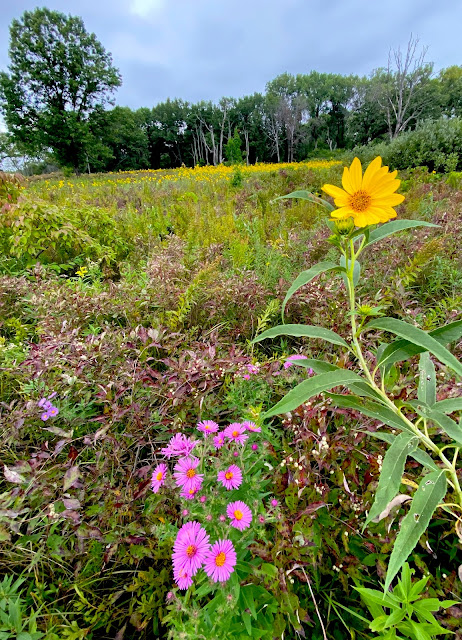Some of us on Oct. 2 will launch a new stewardship community. Might you be part of this team? Please think about it, and if not, might you pass this invitation along to others? (More info coming soon – on this and similar opportunities.)
Shaw Woods, Savanna, and Prairie are super-high-quality and super-threatened gems of nature. We want to restore them to full health. The kick-off is October 2. (Details in Endnote 1.)
The vegetation of Shaw Prairie (shown below) is of rare high quality:
Scarlet painted cup, dropseed, stargrass, valerian, shooting star, and so much more.
The villains in this drama are evil invasives and brush.
In the photo above, the dominant vegetation is invasive shrubs. The purple and yellow flowers here, though colorful, represent species that survive when the brush, in the absence of fire, kills most of the rare diversity.

Would you, for example, like to train to be on the burn crew? With good training, it isn’t that hard; you could be on your first burn in a month. Would you like to learn to find, gather, and prep rare seeds to broadcast where the brush has been controlled? We’ll start teaching that on October 2nd. The same with key brush control techniques. If you already know some of this, do you want to help teach?
Especially hoped for are people who live near Highland Park, Lake Forest, Libertyville, Vernon Hills, Deerfield, or anywhere nearby. Or who are willing to “commute” to learn, be a part, and perhaps then work closer to home. If this mission and adventure might suit you, please come.
Oh, and, sorry, please don’t come if you are pretty sure you don’t have time for this. Later we’ll have tours for interested people, and then you’ll be so welcome! But the Oct. 2 event is for planning, demonstrating, starting the work, and possibly getting to know new friends and colleagues.
That’s the story for now.
This blog will have more detail about this impressive site – and similar sites across Illinois, in other posts, as soon as we can put them together.
If this fits, we hope to see you on October 2nd.
Endnote 1.
The official flyer:
What are these plants? And what do they mean?
The official flyer:
What are these plants? And what do they mean?
These rare plants, thriving here for millennia, indicate a diverse, healthy ecosystem. Hundreds of species of rare butterflies, pollinators of many kinds, beetles, soil microfauna, fungi, bacteria, and other species survive here too. But for the plants, the indicators of all this: the red-orange flower is “scarlet painted cup.” The pinkish white is “shooting star.” The little six-pointed one is “yellow stargrass.” The bunchy yellow flowers are “golden Alexanders.” In a super-fine prairie, every two weeks or so, multiple new species come into bloom, while last month’s flowers are turning into seeds. Some other rare, indicator species that are common here include: valerian, hoary puccoon, prairie dropseed, alumroot, two-flowered Cynthia, dwarf skullcap, and many more.
Endnote 3
The people who opened the way for this new initiative met on an insanely hot day. The only really smart person wore shorts. The rest of us suffered … but felt history in the making.
Note that all these folks are such that none of them will be the core of the needed new community, not for the long haul at least. The cast of characters, from the left: Professor Glenn Adelson (Lake Forest College), Margaret Kelley (the one person who dressed right, Open Lands board member), behind her (nearly invisible, and perhaps the most important person here, wearing the cap) Ryan London (Open Lands' Vice President of Conservation, supervising over 800 acres in nine sites), volunteer Eriko Kojima (experienced steward and mentor for Friends, Somme Woods, Langham Island, and other sites), Mark Ahern (Open Lands board member), volunteer Christos Economou (Friends, Somme Woods, and Plank Road Prairies steward and mentor, point person for the new Shaw launch), Heather Decker (Open Lands restoration ecologist), and Stephen Packard (long a helper to launch biodiversity volunteer stewardship communities, like we expect to emerge here). Photo by Kevin Kerrigan.
For more info check out the Friends web page.
Maps and info about Shaw is on Open Lands web page.
Maps and info about Shaw is on Open Lands web page.
It would help a lot if you could RSVP if you're thinking of coming, tell us a bit about yourself, or ask questions at Shaw kick-off RSVP.
You are so welcome to be in our next photos.






No comments:
Post a Comment